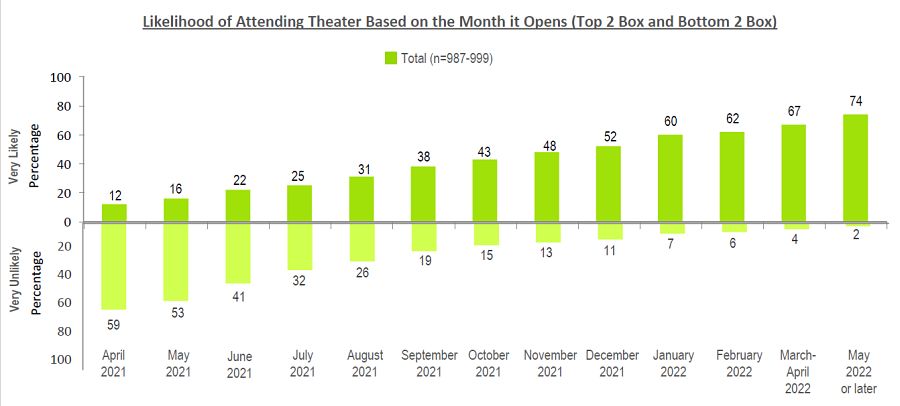ROCKVILLE, MD.: Limelight Insights by Shugoll, a national marketing research company, has announced the results of the third wave of online surveys it has conducted with 1,013 D.C.-area theatregoers on their intent to return to theatres, their online viewing habits, and their attitudes toward systemic racism in theatres since the beginning of the coronavirus pandemic in early 2020. We reported on the previous studies here and here.
With the disclaimer that this wave of the research reflects current expectations about the pandemic, based on anxieties about vaccine distribution and the spread of COVID variants, and that theatregoers may adjust attitudes if they see prospects improve, the findings are unavoidably bleak for theatres. While the majority of theatregoers surveyed eight months ago said they were looking optimistically toward returning to theatres by this May or June, the spread of the virus and the relatively slow rollout of vaccines seem to have spooked them, with a majority (52 percent) saying they don’t consider themselves “very willing” to return until December. That number rises to 60 percent for January 2022, and does not reach at least two thirds of the audience considering themselves very willing to attend shows until March or April of 2022 (67 percent).
While many theatres are planning fall reopenings, only 38 percent of respondents said they are very likely to return in September, and the numbers only creep up to 43 percent by October and 48 percent by November. As before, these likely returning theatregoers tend to be more frequent and/or passionate theatregoers; more than half of this cohort count themselves very willing to attend as early as in October. This might dovetail with the expectation of socially distanced seating, which could reduce audience capacity to sizes closer to the demand for tickets.
And while socially distanced seating in the fall would certainly limit earned income, at this point it appears necessary. A full 83 percent of those surveyed say they expect it to be standard, and just 18 percent say they would attend the theatre in the fall without socially distanced seats. Other safety protocols receive high approval: Temperature checks at the door, mask-wearing, paperless tickets, timed entries and staggered exits all poll at 90 percent or above. Three in four say they’re willing to show proof of a COVID-9 vaccine, with fewer willing to show recent proof of a negative test to gain admission (57 percent). Half of theatregoers say they don’t expect to be able to attend theatre without wearing a mask until next January.
Other findings of the survey include data that show about two thirds of theatregoers (68 percent) have watched online programming from theatres during the pandemic, though they likely to watch it only few times a month (16 percent), once a month (11 percent) or less than once a month (33 percent). Only 37 percent have paid for online content, up from 24 percent in the last survey. It’s a number theatres would need to build if they want to generate more earned income during closure, but they may have reached the limit here: Only 30 percent of those surveyed say they would pay for content if theatres continued to produce online programming, even if the costs were reasonable. One very interesting finding: 20 percent who have watched programming online have done so from a theatre they do not usually attend, presenting opportunities to convert these people into attenders once theatres reopen.
But theatres may want to think twice about relying on this avenue. While some critics predict that online programming will be part of future seasons even after theatres reopen, only 19 percent of those surveyed say they would be very interested in continuing to watch online programming after that point. “This reduced interest in online programming when theatres reopen should be a caution for theatres planning to invest heavily in this new mode of content delivery,” said the study’s author, Cara Shugoll Wilken, in a statement.
Finally, in the midst of growing calls for racial justice at U.S. theatres from activist movements like We See You, White American Theatre, Limelight by Shugoll found that a third of D.C. theatregoers “highly agree” that there is systemic racism at their local theatres which impacts hiring and programming; another 13 percent somewhat agree, for a net of 46 percent agreeing. This agreement splits along racial lines, with 50 percent of African Americans strongly agreeing systemic racism exists in theatres, versus 28 percent of whites.
Creating a more diverse theatre system is very important to area theatregoers, regardless of whether they believe there is systemic racism. Almost two thirds (65 percent) strongly support the idea that area theatres must respond to the concerns expressed by Black and brown artists. A similar percentage (64 percent) strongly feel theatres must take specific steps to fight racism through actionable change in their industry and beyond. Only slightly fewer (57 percent) strongly agree it is important that area theatres more greatly reflect racial diversity in all ways than they do now. “Even with the differences between whites and African Americans,” noted Shugoll Wilken, “these are significant numbers of theatregoers who believe that anti-racism must be a value of theatres.”
A summary of the full report can be found here.


